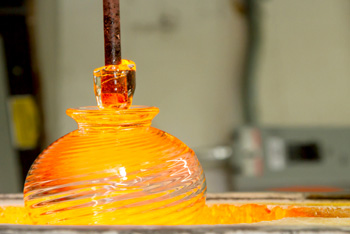 Aug. 13, 2013 – Madison-based artist Quincy Neri designed a glass-blown sculpture installation called the “Mendota Reflection,” photos of which were featured by various project participants. Recently, a federal appeals court ruled in favor of Neri.
Aug. 13, 2013 – Madison-based artist Quincy Neri designed a glass-blown sculpture installation called the “Mendota Reflection,” photos of which were featured by various project participants. Recently, a federal appeals court ruled in favor of Neri.
Neri designed the 60-piece sculpture for Linda Hughes, who had an architecture firm redesign and reconstruct her Madison condo to include a vaulted ceiling that would feature the hanging art, as illustrated in photos on Neri’s website.
A lighting specialist designed the lighting that would display the sculpture, and a photographer took photos of the whole project from start to finish.
The architecture firm, the lighting designer, and the photographer used the photos – which included the sculpture – to illustrate their skills on the project, posting them on company websites and in other publications, including an application for an award.
Neri opposed this use, asserting that all of them violated her copyright in the sculpture. But a federal district court dismissed the case, ruling that Neri lacked a registered copyright. This registration is required to enforce copyrights in court. But a three-judge panel for the U.S. Court of Appeals for the Seventh Circuit vacated that judgment.
In Neri v. Monroe et al., No. 12-3204 (Aug. 12, 2013), the panel disagreed that Neri’s copyright registration, supported by a collection of photographs, was invalid.
Federal copyright law allows artists to submit “unpublished” works by showing copyrightable elements in a work or collection of works. The elements must be in an “orderly form” and “bear a single title identifying the collection as a whole.”
According to testimony, Neri submitted a photo booklet of several sculptures as a collection. However, she submitted photos of the “Mendota Reflection” as loose photos within the booklet. Neri did not submit the booklet itself into the court record.
The lower court dismissed Neri’s case, filed pro se, on the ground that her copyright registration was not submitted in an “orderly form” as required, even though the registration was issued.
“The Register found the submission adequate; a district court should not set aside an agency’s application of its own regulations without a strong reason,” wrote Chief Judge Frank Easterbrook for the three-judge panel.
The panel remanded the case to determine if Neri actually included photos of the “Mendota Reflection” within the booklet submitted to the copyright register. However, it noted other issues the district court should consider first on remand.
One issue involves whether consent to use photos was given by “joint authors.” The architecture firm and Hughes, the customer, had “exercised discretion over the colors and arrangement of the 60 individual glass pieces,” the panel noted.
The panel also noted a potential defense of “fair use,” because project participants had a right to document their own work on the project.
“It was not possible to show what they had accomplished without displaying the sculpture along with the furniture and other aspects of the foyer,” the panel noted.
However, the glass-blower who blew the sculpture’s pieces according to Neri’s design was not the true artist of “Mendota Reflection,” the panel explained, contrary to the defendant’s argument.
“Defendants might as well say that the typesetter owns a book’s copyright or that the members of an orchestra who play a new composition using their own interpretations of the score become the music’s authors,” wrote Chief Judge Easterbrook.
But the appeals panel noted that the glass-blower may have a separate claim, to the extent the he “added features in the course of blowing the glass.”
